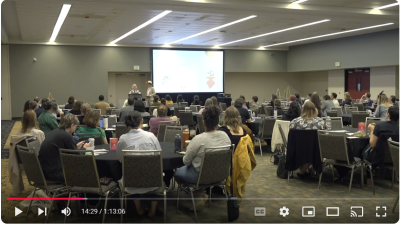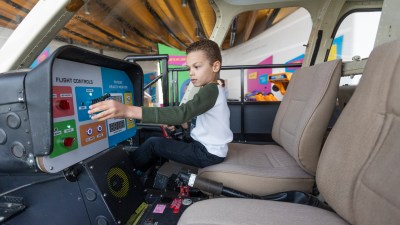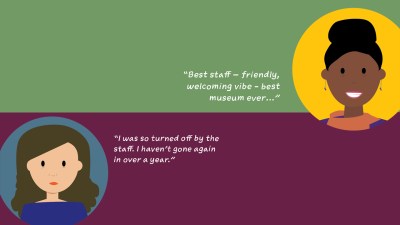
Standing still is the fastest way of moving backwards in a rapidly changing world. — Lauren Bacall
This article originally appeared in Museum magazine’s January/February 2024 issue, a benefit of AAM membership.
The theme of this year’s TrendsWatch report is volatility—strategic foresight parlance for the speed of change. That speed has been increasing exponentially in recent decades. Google’s director of engineering recently predicted that by 2041, we will be experiencing a year of change (by today’s standards) in three months, and by 2071, a year of change in 11 days. That’s the equivalent of 33 years of change in one year! The past 33 years gave us the World Wide Web, email, personal computers, and smartphones; we mapped the human genome and discovered how to edit individual genes. What will it be like to live through that amount of change in just one year? How can we make plans that can survive such rapid transformations?
On one hand, speed can be exhilarating. Open AI’s ChatGPT launched in November 2022; by January 2023 it had 100 million active monthly global users. The user base is projected to grow to 117 million in the US alone by 2025. The technology is amazing: it empowers anyone to be an artist or a writer. It helps students apply to college, journalists draft stories, and architects model the mechanics of their creations. People hope it will make legal services more affordable, education more effective, and brain surgery more accurate. On the surface, generative AI (GenAI) seems like another example of triumphant progress, promising to improve our lives as profoundly as penicillin.
But volatility has another connotation as well, not just rapid but also unpredictable change, often for the worse. It may be thrilling to go fast, but the prospect of rocketing into the future at warp speed, veering erratically, bouncing off obstacles, is terrifying. GenAI is already disrupting whole industries, competing with illustrators, writers, and journalists and displacing 4,000 jobs a month. Goldman Sachs estimates that globally, 300 million current jobs are at risk of being automated by AI. In October 2023, the head of the Securities and Exchange Commission, testifying before the House Financial Services Committee, warned that, absent regulation, it is “nearly unavoidable” that AI will cause a massive financial crisis in the next decade. But that regulation will be hard to implement since the SEC is designed to oversee individual organizations and brokers, not the underlying systems, including AI algorithms, on which these entities rely. Creating effective guardrails for emerging technologies may require us to fundamentally reshape our regulatory infrastructure.
That’s a second, underlying theme of this report: the need to reexamine and reinvent a lot of systems that shape our lives, systems that may have worked more or less well for a couple hundred years but now teeter on the edge of failure. Technology, combined with cultural, environmental, and financial stressors, has widened the partisan divide to the point where approximately 40 percent of all voters, Republican and Democrat, believe that the other side is so extreme that it would be OK to use violence to prevent them from achieving their goals. The same study found a significant share of respondents expressing doubts about the future of democracy and even the United States as it is currently composed. Will we need to reform our civic infrastructure if democracy is to survive?
Emissions from over 200 years of reliance on fossil fuels have resulted in temperatures increasing more in the past 50 years than any 50-year period in the past two millennia. This astounding rate of change challenges our ability to respond: we have been unable to invent, test, and implement solutions fast enough to keep global CO2 below critical levels. At the same time, we have to deal with the literal volatility of the climate crisis. Last year was the hottest on record, with four months in a row of record-breaking temperatures and the skies blanketed by the smoke of nearly 46 million acres burning across Canada—nine times the historical average. While some believe that technology can save us, it’s clear that even with the best technologies, we will need to eat less meat, travel less often, and take up less space (in our homes and on the planet) to stick to a strict carbon diet.
Does all this seem intimidating? It does to me. One comforting thought: humans are supremely adaptable to change. Our great grandparents may have been terrified to hurtle down the highway at 75 mph—now we are so blasé about that speed we have to be reminded to keep both hands on the wheel (and thumbs off our phones). So maybe by the time humans reach 33 years of change in one year, this volatility will seem normal.
Another important thing to keep in mind: while some of this acceleration is beyond the control of any one individual, organization, or country, there are things we can do to apply the brakes. We can take the time to savor the process of putting words on paper rather than using AI to generate our correspondence. We can choose to challenge the supremacy of efficiency and value the benefits of measured, thoughtful collaboration. Museums, as cultural influencers, can offer their communities a place to slow down and decompress. They can ally with the movements promoting slow art, slow tourism, and slow food. And we can remind each other that we don’t have to go fast just because we can.
In the face of a volatile future, it’s critical to cultivate what Dr. Jane McGonigal, of the Institute for the Future, calls “urgent optimism”: the desire to act immediately to tackle an obstacle, combined with the belief that we have a reasonable hope of success. I hope this report will foster that hope and leave you feeling empowered to make a difference.
Yours from the future,
Elizabeth Merritt
Vice President, Strategic Foresight, and Founding Director, Center for the Future of Museums, American Alliance of Museums
How to Use this Report
Use this edition of TrendsWatch as a catalyst for adapting to your museum’s rapidly changing environment:
- What choices does your museum face regarding the utility and ethics of artificial intelligence?
- How can your museum reduce its carbon emissions and inspire the public to take action?
- When might your organization be caught up in the current culture wars, and how can you prepare strategies to respond?
- Who is currently excluded by your museum’s hiring processes, and could you diversify your applicant pool by dropping unnecessary degree requirements?
Each article includes a list of things museums might do to tackle these issues. Share this report with your students, clients, colleagues, staff, volunteers, and board of trustees to foster discussion about how your organization will cope with a volatile future.
What Is TrendsWatch?
TrendsWatch is the annual forecasting report produced by the Center for the Future of Museums, the American Alliance of Museums’ think tank and idea laboratory for the museum field. Each edition is built on a year’s worth of scanning and analysis of news, research, and conversations. The report goes out to members and subscribers as the January/February issue of Museum magazine, and a PDF version is released on the AAM website at the end of March. You can find dozens of embedded links to original sources for the information referenced in this text in the digital issue of Museum and in the PDF.
The text for this report was written by CFM’s director, Elizabeth Merritt, with input and advice from many people inside and outside the museum sector. (See page 1 for the list of people who reviewed and commented on the articles.) We encourage you to join this conversation. Please share your thoughts and questions by:
- Joining the Future of Museums Community on AAM’s Museum Junction discussion forum.
- Submitting guest posts to the CFM blog.
- Emailing CFM at emerritt@aam-us.org.
Elizabeth and her colleagues are available to support your work via speaking engagements, workshops, moderating discussions, and consulting. For more information on those services and to request our help, visit the Alliance Advisory Services and Speakers Bureau on the AAM website.









I am Director of the Environmental Sciences Museum of the University of Guadalajara, Jalisco, México. Our mission is “understanding the city and inspiring the conservation of nature that sustains it, and catalyzing social and ecological changes for the benefit of our community”. We are in the process of finishing the construction of our 23,000 m2 building, but since we started the museum design in 2009 we initiated the JEP City and Nature International Literature Award, the Socio-environmental Film Program, and educational and cultural activities and exhibitions in formal and community environments.